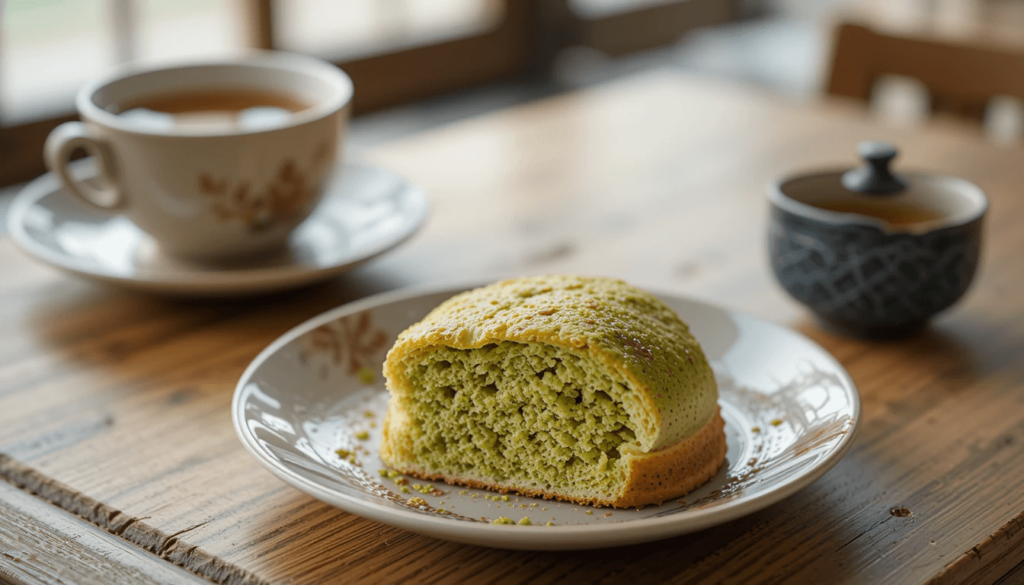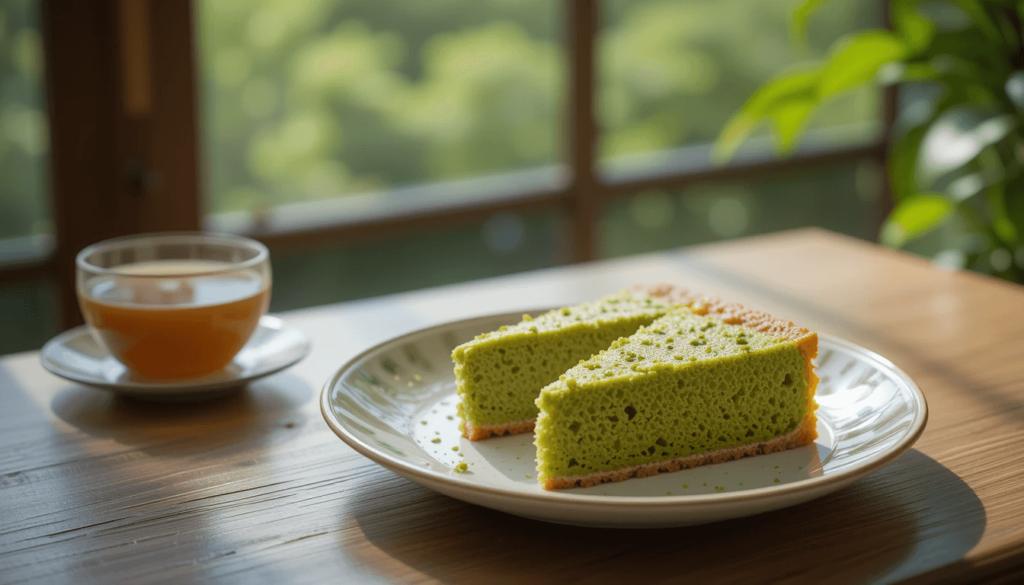Introduction
Matcha Pan has become a beloved treat that bridges the gap between traditional Japanese flavors and the comforting softness of freshly baked bread. With its distinctive green color and unique taste, this Japanese-style bread has gained popularity not only in Japan but across the globe. The fusion of the earthy, slightly sweet flavor ofgreen tea bread with the soft, airy texture of bread makes matcha-flavored loafa perfect snack for any time of day, from breakfast to a cozy afternoon tea.
What makes Matcha Pan so intriguing is its ability to incorporate the rich, antioxidant-packed properties of matcha green tea into something as universally loved as bread. Matcha, a finely ground powder made from specially grown green tea leaves, has been a central part of Japanese culture for centuries, particularly in tea ceremonies and traditional sweets. However, its use in baking has brought a modern twist to this ancient tradition.
The bread itself is nothing short of delightful. Each bite offers the perfect balance between the natural bitterness of matcha and the subtle sweetness of the dough. The vibrant green hue of the bread makes it stand out, not just for its flavor but for its visual appeal as well. Whether you’re enjoying it plain, paired with a cup of tea, or filled with sweet fillings like red bean paste, green tea loaf offers versatility, making it a perfect choice for various occasions.
In this guide, we will dive deep into everything about matcha bread. We’ll explore its origins, how it’s made, the essential ingredients that contribute to its unique flavor, and tips on how to bake it yourself. Whether you’re an experienced baker or a newcomer to Japanese-inspired pastries, this guide will equip you with all the knowledge you need to master the art of making matcha-flavored loaf at home. We’ll also take a look at the health benefits of matcha, why this bread makes a perfect pairing with various drinks, and how it can fit into special dietary needs.
Get ready to embark on a flavorful journey! Grab your apron, and let’s explore the wonderful world of green tea loaf—a treat that blends tradition with innovation, creating a bread that’s as delightful for the taste buds as it is for the soul.
What is Matcha Pan?
The Origins of Matcha Pan
Matcha Pan is a traditional Japanese bread that combines the rich taste of green tea loaf , finely ground green tea powder, with soft, pillowy bread. The roots of matcha go back to the 9th century in Japan, where it was originally used for religious and ceremonial purposes. Over time, the use of matcha expanded into cooking and baking, leading to the creation of unique dishes like matcha-flavored loaf. The addition of matcha to bread brings a touch of sophistication and health benefits, making it a perfect snack or breakfast item.
What Makes Matcha Pan Unique?
Unlike other flavored breads, Matcha Pan stands out because of its earthy, slightly bitter flavor that complements the sweetness of the bread. The vibrant green color adds a visually stunning element to the bread, making it a favorite for those looking to combine flavor and aesthetics. The matcha not only adds a unique flavor but also enhances the nutritional profile of the bread with antioxidants, vitamins, and minerals.
Matcha Pan Ingredients

Key Ingredients in Matcha Pan
Making matcha-flavored loaf requires a few simple ingredients that are common in baking. The key ingredients include:
- Flour: All-purpose flour is the base for Matcha , providing the soft, airy texture typical of Japanese-style breads.
- Matcha Powder: The most important ingredient! Matcha gives the bread its distinctive green color and earthy flavor. Make sure to use high-quality, culinary-grade matcha for the best results.
- Sugar: A small amount of sugar helps balance out the natural bitterness of the matcha, providing a sweet contrast.
- Yeast: Active dry yeast helps the bread rise, giving it that perfect fluffy texture.
- Butter: Adds richness and moisture to the bread.
- Milk: Adds tenderness to the dough, helping it stay soft.
- Salt: Balances the flavors and enhances the overall taste.
Why Matcha Powder is Essential for the Perfect Matcha Pan
Matcha powder is the heart and soul of this bread. It’s not just about flavor; matcha contributes to the bread’s distinct green hue, creating a beautiful visual appeal. The health benefits of matcha are an added bonus. Packed with antioxidants, vitamins, and minerals, matcha supports metabolism, reduces inflammation, and can boost energy levels. When used in baking, matcha brings a touch of tradition, flavor, and wellness to each bite.
How to Make Matcha Pan at Home
Step-by-Step Guide to Making Matcha Pan
If you’re ready to give this delicious treat a try, here’s how you can make Matcha Pan at home.
- Prepare the Ingredients: Begin by measuring out your flour, matcha powder, sugar, and yeast. In a small bowl, mix the yeast with warm milk and a pinch of sugar. Let it sit for about 5 minutes until it becomes frothy.
- Mix the Dry Ingredients: In a large mixing bowl, combine the flour, matcha powder, and salt. Mix well to ensure the matcha is evenly distributed throughout the flour.
- Combine Wet and Dry Ingredients: Add the yeast mixture and softened butter into the dry ingredients. Mix everything together until a dough forms.
- Knead the Dough: Transfer the dough onto a clean, floured surface and knead for 8-10 minutes until the dough becomes smooth and elastic. If the dough is too sticky, add a little more flour as needed.
- Let the Dough Rise: Place the kneaded dough in a bowl, cover it with a clean towel, and let it rise in a warm area for about 1 hour or until it doubles in size.
- Shape the Dough: After the dough has risen, punch it down to release air bubbles. Divide the dough into smaller pieces and shape each piece into a round ball or log, depending on your preference.
- Second Rise: Place the shaped dough on a baking tray lined with parchment paper. Cover and let it rise for an additional 30 minutes.
- Bake: Preheat your oven to 350°F (175°C). Once the dough has risen, bake for 20-25 minutes, or until golden brown. Cool on a wire rack before serving.
Common Mistakes to Avoid When Baking Matcha Pan
- Using low-quality matcha: Always use high-quality, culinary-grade matcha powder to ensure the best flavor and color.
- Over-kneading the dough: Knead just enough to develop the gluten; over-kneading can result in dense bread.
- Not allowing enough time for the dough to rise: Don’t rush the rising process. Patience is key to achieving light, fluffy bread.
- Baking at the wrong temperature: Make sure to preheat your oven and bake the bread at the recommended temperature to achieve the perfect golden-brown crust.
Health Benefits of Matcha Pan
Why Matcha is Healthy
Matcha is known for its many health benefits. It’s packed with antioxidants, which help protect the body from free radicals. These antioxidants also support metabolism and may help with weight management. Additionally, matcha contains L-theanine, an amino acid that promotes relaxation and reduces stress. The presence of fiber, vitamins, and minerals also contributes to a healthier diet when consumed in moderation.
Nutritional Benefits of Eating Matcha Pan
While Matcha Pan is primarily a treat, it does provide some health benefits due to the matcha powder in the dough. By incorporating matcha into your diet, you’re adding a source of antioxidants, including catechins, which are known to reduce inflammation and improve heart health. The bread itself is a good source of carbohydrates and fiber, helping to fuel the body and keep you feeling satisfied for longer periods.
Different Varieties of Matcha Pan
Sweet vs. Savory Matcha Pan
While traditional Matcha Pan is typically sweet, there are savory versions that incorporate matcha into the dough while pairing it with ingredients like cheese or herbs. Sweet Matcha Pan tends to have a sugar glaze or is filled with sweet red bean paste, creating a delightful dessert. On the other hand, savory Matcha Pan pairs well with ingredients such as sesame seeds or even a little bit of salt to balance the flavor.
Regional Variations of Matcha Pan in Japan
In Japan, Matcha Pan can vary from region to region. Some regions may offer Matcha Pan filled with sweet fillings like custard or cream. In other regions, the bread may be slightly denser, reflecting the local baking traditions. You might even find Matcha Pan with regional twists, such as a layer of matcha-flavored cream or a marbled matcha and plain dough.
Matcha Pan: Best Pairings and Serving Suggestions

Best Beverages to Pair with Matcha Pan
Matcha Pan pairs wonderfully with a variety of beverages. For a traditional Japanese experience, try it with a warm cup of Matcha Tea. The subtle flavor of the tea complements the bread without overpowering it. If you’re looking for something different, a mild green tea or even a cup of black coffee works well. For a sweeter pairing, enjoy your Matcha Pan with a glass of iced matcha latte or a creamy chai tea.
Serving Suggestions for Different Occasions
Matcha Pan can be served in many ways, depending on the occasion. For a light breakfast or brunch, serve it with a side of fruit and a hot beverage. For a more indulgent treat, serve it with a scoop of vanilla ice cream and a drizzle of honey. Matcha Pan is also a great addition to any Japanese-themed party or tea ceremony.
Where to Find Matcha Pan

Popular Bakeries and Cafes Selling Matcha Pan
If you’re not in the mood to bake, there are plenty of bakeries and cafes that offer delicious Matcha Pan. In Japan, you’ll find this delightful bread in almost every bakery, especially those that specialize in traditional Japanese confections. Internationally, many bakeries, especially those with a focus on Japanese or Asian pastries, offer Matcha Pan. Look out for local Asian bakeries or specialty stores that carry unique breads and pastries.
Finding Authentic Matcha Pan Near You
If you’re searching for authentic Matcha Pan near you, start by visiting Japanese cafes or bakeries. Many modern cafes are now experimenting with matcha, offering various types of matcha-flavored pastries, including Matcha Pan. Use Google or food apps to locate Japanese bakeries or tea houses that offer this unique treat.
Matcha Pan for Special Dietary Needs
Vegan and Gluten-Free Matcha Pan Recipes
For those with dietary restrictions, it’s still possible to enjoy Matcha Pan. A vegan Matcha Pan recipe would typically replace dairy ingredients like butter and milk with plant-based alternatives such as almond milk or coconut milk. For a gluten-free version, you can swap out all-purpose flour for gluten-free flour blends. Though adjustments may be needed, these alternatives still produce a flavorful result.
How to Adjust Matcha Pan Recipes for Healthier Alternatives
To make a healthier version of Matcha Pan, you can substitute some of the refined sugar with natural sweeteners like honey or maple syrup. For added nutrition, you might include whole wheat flour instead of white flour, or add seeds like chia or flax for a boost of omega-3 fatty acids.
Frequently Asked Questions about Matcha Pan
Common Queries About Matcha Pan Answered
What is the difference between Matcha Pan and regular bread?
Matcha Pan is made with matcha powder, giving it a distinct green color and a rich flavor. Unlike regular bread, Matcha Pan contains matcha, which adds a slight bitterness and enhances the overall flavor profile.
Can I make Matcha Pan without yeast?
While yeast is typically used for that soft, fluffy texture, you can try making a quick bread version without yeast. However, it will lack the airy texture that yeast provides.
How do I store leftover Matcha Pan?
Store leftover Matcha Pan in an airtight container at room temperature for up to 2 days. For longer storage, you can freeze the bread and thaw it when you’re ready to eat.
Is Matcha Pan good for breakfast?
Yes! Matcha Pan makes for a great breakfast choice due to its subtle sweetness and satisfying texture. Pair it with a warm beverage for a balanced meal.
Can I make Matcha Pan ahead of time?
Yes, you can prepare the dough the night before and let it rise overnight in the refrigerator. Then, you can bake it fresh the next day.
Conclusion
https://matcha.com/blogs/news/the-history-of-matcha
Matcha Pan is not just a trendy dessert that has caught the eyes of foodies and bakers alike. It’s a delicious and versatile bread that brings the vibrant, earthy essence of matcha to your table. This Japanese-inspired treat offers a unique twist on traditional bread by blending the soft, pillowy texture of freshly baked dough with the rich, slightly bitter flavor of matcha green tea.
The result is a harmonious balance of sweetness and bitterness, with an undeniable satisfaction that comes from enjoying a slice of warm, comforting bread. Whether you enjoy it as a breakfast staple, pair it with your afternoon tea, or share it with friends and family, Matcha is sure to become a favorite.
It not only delights the taste buds but also nourishes the soul, offering a perfect blend of tradition and innovation. The combination of soft dough and matcha’s distinct flavor makes every bite a memorable experience, one that will leave you craving more.
One of the things that makes matcha bread, so special is the way it encapsulates the essence of Japanese culinary tradition while offering a modern twist. Matcha, which has been celebrated for centuries for its health benefits and rich cultural significance, brings a unique flavor to the bread that is both subtle and bold. The delicate bitterness of the matcha perfectly complements the light sweetness of the dough, making it an irresistible treat for any time of day. Plus, with its vibrant green color, Matcha Pan is not only a treat for your taste buds but also a feast for the eyes, turning any meal into something more exciting and aesthetically pleasing.
Beyond its delightful flavor and beauty, Matcha Pan also offers health benefits thanks to the matcha itself. Packed with antioxidants, vitamins, and minerals, matcha is known for its ability to boost metabolism, promote relaxation, and even provide an energy lift without the jitters commonly associated with coffee. By incorporating matcha into your baking, you’re adding a nutritional powerhouse to your diet—making Matcha Pan not just a delicious indulgence but a healthier alternative to many other sweet treats.
Now that you’ve explored the world of Matcha Pan, you’re equipped with all the tools and knowledge to bake your own at home. From understanding the ingredients and the step-by-step process to learning how to shape and bake the dough, you’ve got everything you need to create this Japanese-inspired bread with ease. And, as you gain more experience, you can start experimenting with different variations—whether it’s adding fillings like sweet red bean paste, trying savory versions with cheese or herbs, or even adapting the recipe to fit vegan or gluten-free diets.
The best part is that making matcha bread, at home allows you to infuse it with your own personal touch. You can adjust the sweetness, experiment with different baking techniques, or create a loaf that’s perfectly suited to your tastes and dietary preferences. Whether you’re baking for yourself, your family, or hosting a gathering with friends, Matcha Pan is guaranteed to impress. Its inviting aroma, delightful texture, and satisfying flavor will have everyone asking for seconds.
What makes Matcha Pan so special is how it blends Japanese tradition with modern flavors. Matcha, celebrated for centuries for its health benefits and cultural significance, adds a rich, earthy note to the bread. The vibrant green color of Matcha Pan not only makes it visually stunning but also sets it apart from traditional bread, offering a fun and unique twist on your baking.
Beyond its flavor, Matcha Pan also offers health benefits. Matcha is packed with antioxidants, vitamins, and minerals that support metabolism, reduce stress, and even help with energy levels. By incorporating matcha into your baking, you’re adding a nutritional boost to your treat—making it a healthier option compared to many other sweets.
Now that you’ve explored the world of Matcha Pan, you’re ready to try making your own at home. From understanding the key ingredients to mastering the baking process, you have all the tools needed to bake this delightful bread. As you become more comfortable with the recipe, you can start experimenting with variations, like adding sweet fillings or making vegan and gluten-free versions.
The beauty of Matcha Pan is that you can personalize it to fit your tastes. You can adjust the sweetness, try savory variations, or even play around with different fillings like red bean paste or custard. Whether you’re baking for yourself, sharing with family, or impressing friends, this bread is sure to be a hit.
So, why wait? Get into the kitchen and try baking Matcha Pan today! With its irresistible aroma, soft texture, and vibrant green color, this bread is perfect for any occasion. Whether you’re following the traditional recipe or making your own adjustments, you’ll be proud of the delicious results. Once you’ve tasted Matcha Pan, you won’t be disappointed. Happy baking!u won’t be disappointed. Happy baking!


